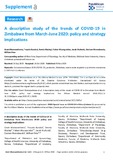Please use this identifier to cite or link to this item:
https://cris.library.msu.ac.zw//handle/11408/4308Full metadata record
| DC Field | Value | Language |
|---|---|---|
| dc.contributor.author | Murewanhema, Grant | - |
| dc.contributor.author | Burukai, Trouble | - |
| dc.contributor.author | Mazingi, Dennis | - |
| dc.contributor.author | Maunganidze, Fabian | - |
| dc.contributor.author | Mufunda, Jacob | - |
| dc.contributor.author | Pote, William | - |
| dc.date.accessioned | 2021-06-01T10:52:47Z | - |
| dc.date.available | 2021-06-01T10:52:47Z | - |
| dc.date.issued | 2020 | - |
| dc.identifier.issn | 1937-8688 | - |
| dc.identifier.uri | https://www.panafrican-med-journal.com/content/series/37/1/33/full/ | - |
| dc.identifier.uri | http://hdl.handle.net/11408/4308 | - |
| dc.description.abstract | Introduction: the first cases of COVID-19 were reported in China in December 2019. Since then, the disease has evolved to become a global pandemic. Zimbabwe reported its first case on 20th March 2020, and the number has been increasing steadily. However, Zimbabwe has not witnessed the exponential growth witnessed in other countries so far, and the trajectory seems different. We set out to describe the epidemiological trends of COVID-19 in Zimbabwe from when the first case was confirmed to June 2020. Methods: data were collected from daily situation reports that were published by the Zimbabwean Ministry of Health and Child Care from 20th March to 27th June 2020. Missing data on the daily situation reports was not imputed. Results: as of 27th June 2020, Zimbabwe had 567 confirmed COVID-19 cases. Eighty-two percent of these were returning residents and 18% were local transmission. The testing was heavily skewed towards returnees despite a comprehensive testing strategy. Of the confirmed cases, 142 were reported as recovered. However, demographic data for the cases were missing from the reports. It was not possible to estimate the probable period of infection of an active case, and case fatality in Zimbabwe was about 1% for the first 4 months of the pandemic. Conclusion: the epidemiological trends of COVID-19 experienced in Zimbabwe between March and June 2020 are somewhat different from what has been observed elsewhere. Further research to determine the reasons for the differences is warranted, to inform public health practice and tailor make suitable interventions. | en_US |
| dc.language.iso | en | en_US |
| dc.publisher | NLM (Medline) | en_US |
| dc.relation.ispartofseries | Pan African Medical Journal;Vol.37 ; No.1 | - |
| dc.subject | Coronavirus disease 2019 (COVID-19) | en_US |
| dc.subject | pandemic | en_US |
| dc.subject | Zimbabwe | en_US |
| dc.subject | severe acute respiratory syndrome coronavirus 2 | en_US |
| dc.subject | SARS-CoV-2 | en_US |
| dc.subject | infection | en_US |
| dc.title | A descriptive study of the trends of COVID-19 in Zimbabwe from March-June 2020: policy and strategy implications | en_US |
| dc.type | Article | en_US |
| item.openairetype | Article | - |
| item.openairecristype | http://purl.org/coar/resource_type/c_18cf | - |
| item.grantfulltext | open | - |
| item.cerifentitytype | Publications | - |
| item.fulltext | With Fulltext | - |
| item.languageiso639-1 | en | - |
| Appears in Collections: | Research Papers | |
Files in This Item:
| File | Description | Size | Format | |
|---|---|---|---|---|
| murewanhema.pdf | Article | 868.85 kB | Adobe PDF |  View/Open |
Page view(s)
162
checked on Nov 29, 2025
Download(s)
40
checked on Nov 29, 2025
Google ScholarTM
Check
Items in MSUIR are protected by copyright, with all rights reserved, unless otherwise indicated.



